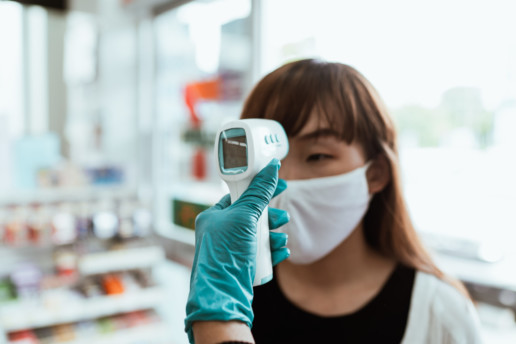COVID-19 at-home testing kits can make returning to work safer
As many begin to return to the workplace, both employers and employees are fearful of bringing the COVID-19 virus into the workplace. A company has produced an at-home testing kit for those returning to work. Read this blog post to learn more.
While access to wide-spread coronavirus testing is still a barrier for millions of Americans, computer software company Appian is partnering with Everlywell, a digital health company, to offer COVID-19 at-home testing kits for employees returning to the workplace.
“Everlywell was founded to give people access to high-quality lab tests that can be taken at home,” said Julia Cheek, founder and CEO of Everlywell. “We are proud to support Appian’s customers in providing FDA-authorized COVID-19 testing to help keep them safe.”
Since March, more than 50 million coronavirus tests have been reported to the CDC, of which 5 million were positive. But as states reopen their economies and infection rates increase, there are growing concerns about supply chain problems, according to Politico. Reopening has increased demand for testing, causing samples to pile up faster than labs can analyze them, which is lengthening turnaround times for results — complicating efforts to contain the virus.
Everlywell’s at-home lab tests seek to streamline the process of testing for their employer clients. The COVID-19 test will be integrated within the Appian Workforce Safety solution. Through the partnership, people using Appian’s return-to-site solutions will be able to request home delivery of Everlywell’s COVID-19 testing kit by taking a screening questionnaire based on CDC guidelines. Each test request will be reviewed by an independent physician from Everlywell’s third-party telehealth partner. Test results can be delivered to the test-taker’s mobile device in 24-48 hours after the sample arrives at an authorized lab.
The lab tests have received emergency use authorization from the Food and Drug Administration. The testing used by the company and its lab partners meet the FDA’s performance criteria for COVID-19 test accuracy, and telehealth consultations are included for those who test positive.
“How much you know as an organization is how much you can protect the members of your organization,” says Matt Calkins, CEO of Appian. “This is the fastest way to get information on infection. We've seen that high amounts of testing can help minimize COVID-19. Knowledge is power, so we're trying to get [employers] as much knowledge as possible, as quickly as possible, and provide them with another tool to keep their employees safe.”
As employers make their strategies for returning to work, workplace safety is of top concern. Antibody screening, thermal cameras and on-site nurses are all methods being considered to help employees stay safe. Digital health is playing a major role in helping employees self-report their risks, whether that be the employee taking the subway, or living with someone who’s immunosuppressed. It can also help employers scalably monitor and assess people's symptoms on a daily basis, ensuring that sick employees stay at home and quarantine. Workplace changes may also include desks and workstations being spread further apart, and stricter limitations on large meetings and gatherings in the office.
Appian’s platform helps employers centralize and automate all the key components needed for safe returns to work. Through the platform, employers can process health screenings, return-to-site authorizations, contact tracing, isolation processing, and now, COVID-19 testing.
“A lot of people would rather work with an employer who goes the extra mile, who’s willing to offer and pay for tests if necessary for their own employees, and to quickly deploy it, where there’s even a suspicion of transmission,” Calkins says. “It’s a responsible gesture and a serious signal that the employer cares about the health of their workforce, and employees are reassured that their colleagues are more likely to be healthy.”
SOURCE: Nedlund, E. (30 July 2020) "COVID-19 at-home testing kits can make returning to work safer" (Web Blog Post). Retrieved from https://www.employeebenefitadviser.com/news/covid-19-at-home-testing-kits-can-make-returning-to-work-safer
SHRM: Employers Consider Safety Precautions for Return to Workplace
As employers begin to look at what lies ahead in regards to returning to the workplace, they also have to begin looking at what precautions they need to consider in order to keep the workplace safe for everyone involved. Read this blog post to learn more.
Nearly half of organizations surveyed have not announced a return-to-work date as COVID-19 restrictions ease in some parts of the country, but a majority of HR professionals think setting even a tentative date is a good idea.
The findings from new Society for Human Resource Management (SHRM) research released June 9 illustrate how U.S. employers are considering a phased return of employees, staggered start and stop times, health precautions, and physical changes to their worksites.
Setting a return date is a good idea, two-thirds of HR professionals said, because it eases job-security concerns among staff, especially for those in physical and service industries such as health care, retail and education. Employers that have established a date prefer employees to return on or before June 30, according to more than three-fourths of HR professionals.
Much of what an organization decides to do depends on its size and industry.
Large employers—those with 500 or more employees—were less likely to have announced a return date. This was especially true in knowledge industries. However, organizations in those industries—finance, consulting, engineering and administrative services companies—also were more likely to let employees continue to work from home and determine when they want to return to the worksite.
Industries where the work is more physical—construction, manufacturing and transportation—were more likely to have already reopened their physical locations and to implement an alternating work schedule.
Other strategies include:
- Staggering the start and stop of employees' workdays as well as break times so as to reduce the number of workers in one location at the same time (75 percent).
- Reducing the number of customers permitted on site at one time and taking measures such as counting the number of people as they enter (78 percent).
- Limiting the number of employees or customers on site at one time (81 percent).
The research is based on a SHRM survey that collected responses May 13-20 from a random sampling of 1,087 SHRM members working in HR. Academicians, students, consultants, people who are self-employed or retired, and HR professionals who were furloughed or laid off were excluded from the sample.
“This research gives a glimpse into how COVID-19 has changed the world of work, and what workplaces will look like once we return,” said Johnny C. Taylor, Jr., SHRM-SCP, SHRM's president and CEO. “Workers should expect to see more masks, fewer handshakes, marked floors, more barriers, and greater flexibility—especially when it comes to remote work.”
Among employers implementing a phased-return plan, one-third intend to do so by specific departments or functions. Others are first bringing back employees with lower health risks or those in leadership positions. The length of the phased return also varies, from two weeks to more than three months.
"Getting back to work takes a lot of work," Taylor noted, "and HR professionals have played an essential role in drawing up plans that drive organizations forward and protect public health.”
SOURCE: Gurchiek, K. (09 June 2020) "SHRM: Employers Consider Safety Precautions for Return to Workplace" (Web Blog Post). Retrieved from https://www.shrm.org/hr-today/news/hr-news/pages/shrm-employers-consider-safety-precautions-for-return-to-workplace.aspx


